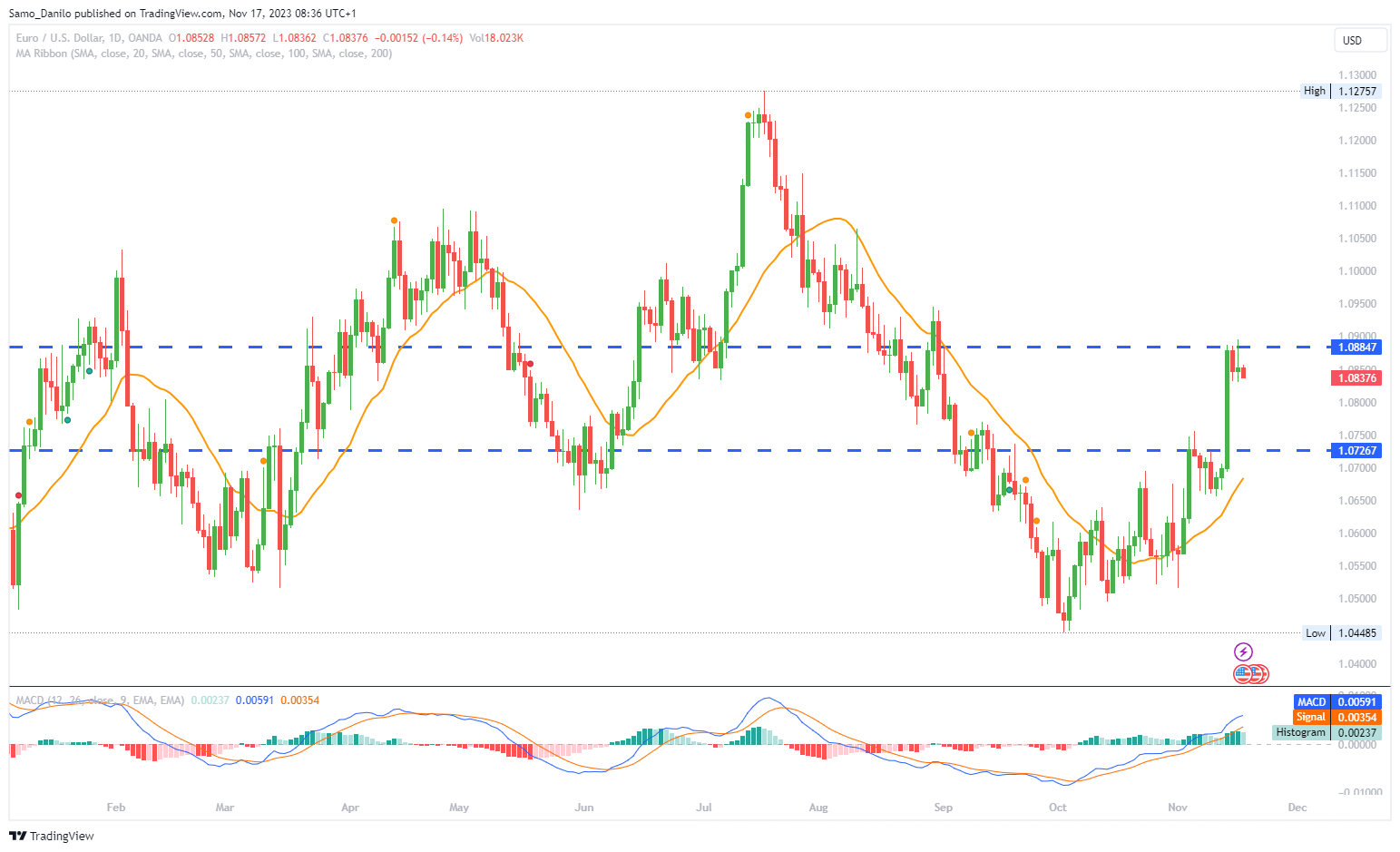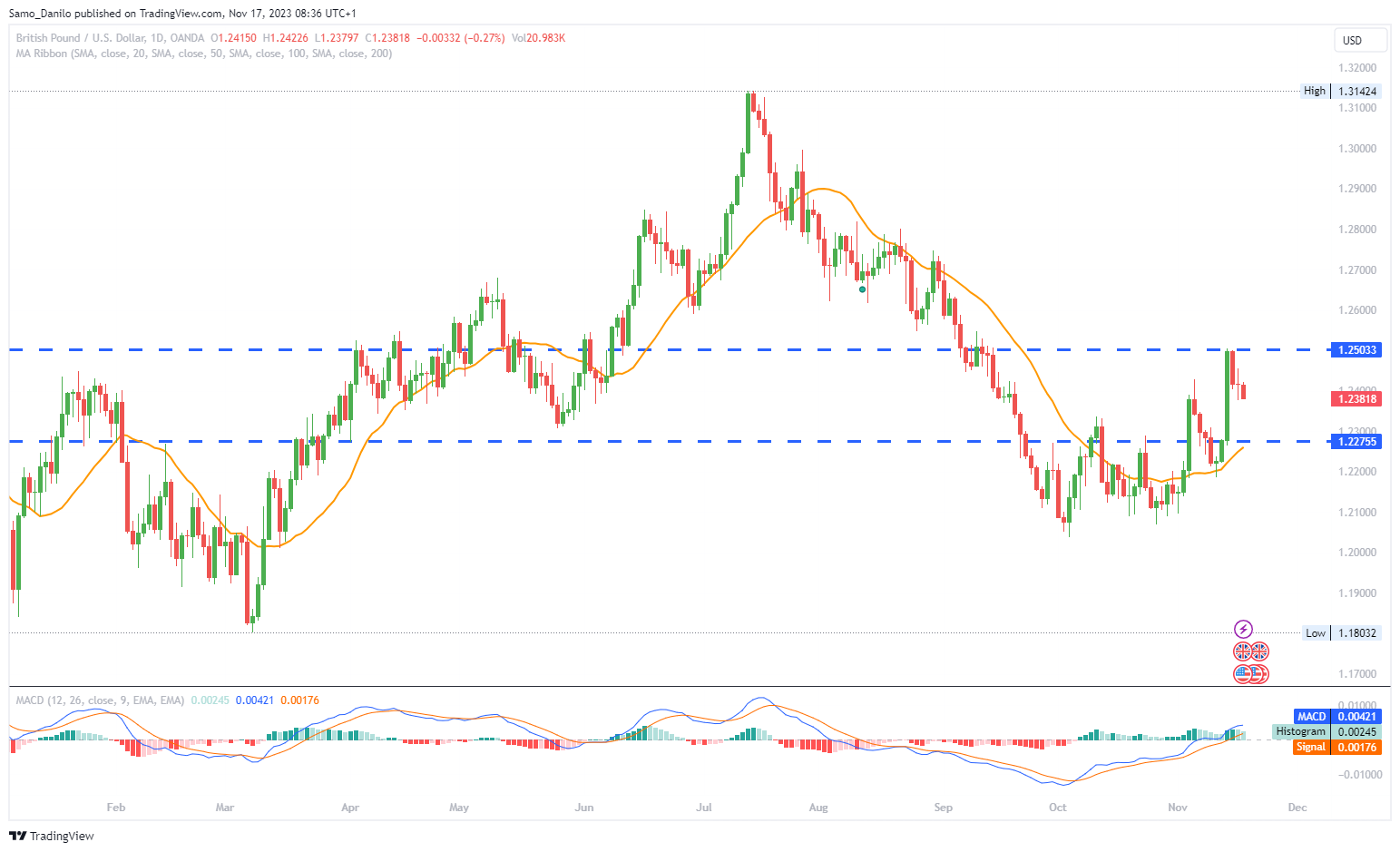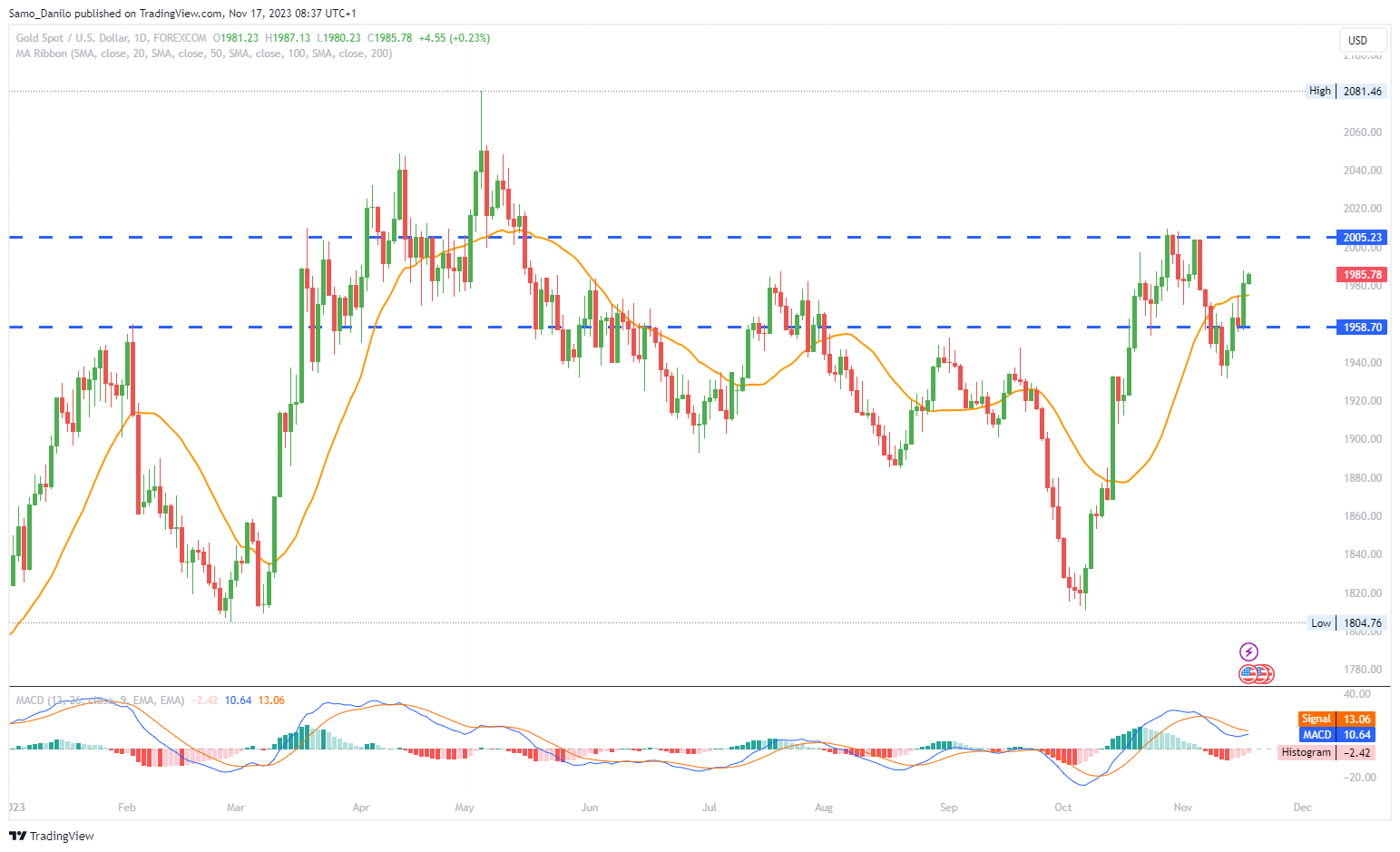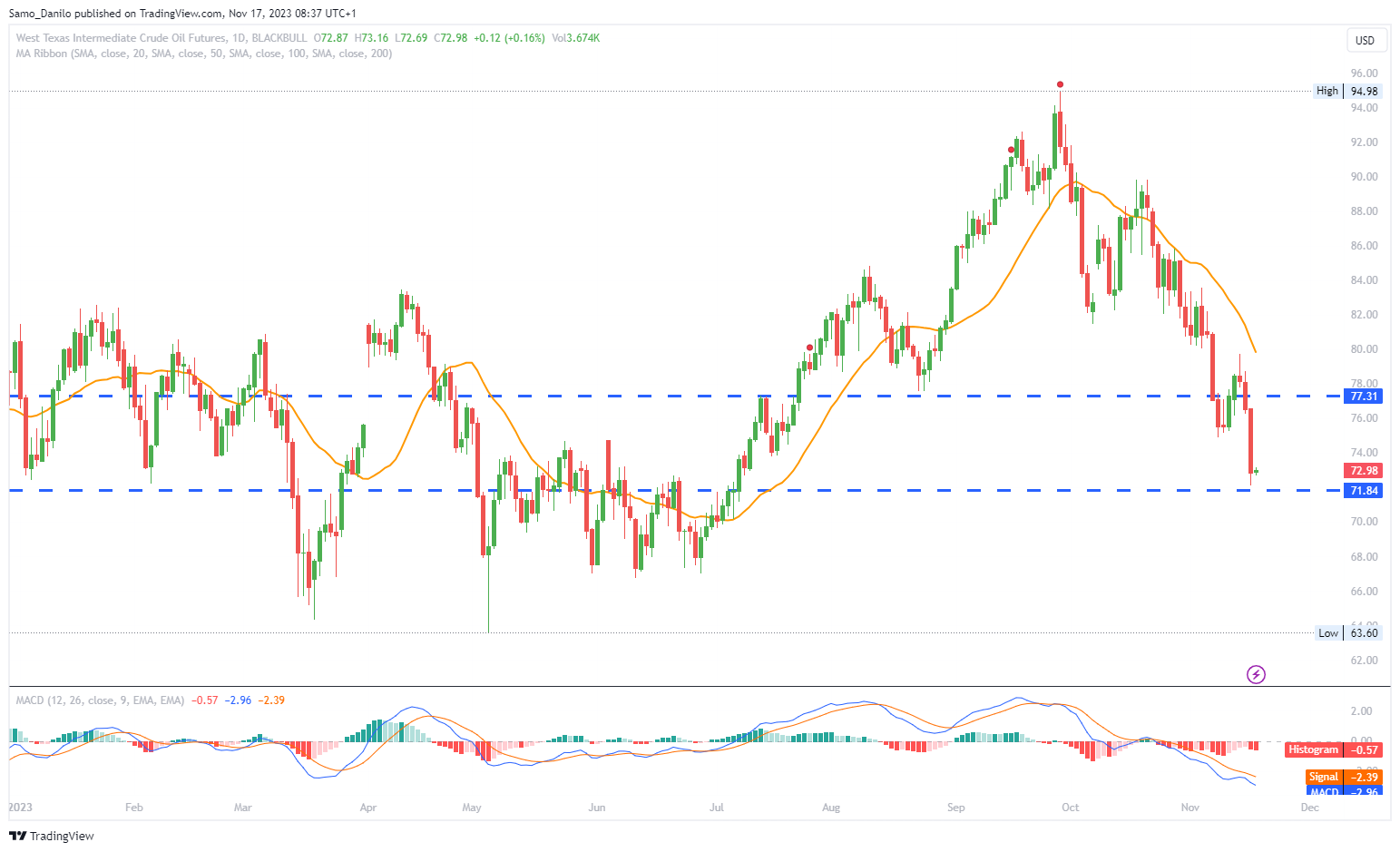EURUSD
- EUR/USD is struggling to gain meaningful traction and is oscillating in a range on Friday. The spot prices are currently trading around the mid-1.0800s, nearly unchanged for the day.
- The recent softer US Consumer Price Index (CPI) report is mentioned as a backdrop for the struggle in EUR/USD. This report has implications for the Federal Reserve's policy outlook, as it boosts disinflation hopes and brings the Fed closer to its 2% target.
- The recent slump in Crude Oil prices is noted as a factor influencing the disinflation expectations and supporting the view that the Fed may not raise interest rates further.
- A larger-than-expected rise in US Initial Jobless Claims is highlighted as a sign of a cooling labor market. This reaffirms expectations that the Fed may not pursue further interest rate hikes.
- Bets that the European Central Bank (ECB) could start cutting rates in March 2024 are mentioned as a factor holding back traders from placing aggressive bullish bets on the Euro. This expectation contributes to capping gains for the EUR/USD pair.
- Bets that the European Central Bank (ECB) could start cutting rates in March 2024 are mentioned as a factor holding back traders from placing aggressive bullish bets on the Euro. This expectation contributes to capping gains for the EUR/USD pair.
Closing statement:In summary, the EUR/USD is currently in a consolidation phase, with factors such as the US CPI report, Crude Oil prices, labour market conditions, and ECB rate cut expectations influencing its movement. Traders are awaiting key economic data, including Eurozone CPI and US housing market figures, for further insights and potential directional cues.
GBPUSD
- GBP/USD is poised to extend its losses for the third consecutive day, currently trading around 1.2390 during the Asian session on Friday.
- Retail sales volumes in the United Kingdom declined by 0.3% in October compared to the previous month. This data, revealed by the Office for National Statistics, is mentioned as a factor influencing the recent movements in GBP/USD.
- Traders are expected to take cues from speeches by influential members of the Federal Open Market Committee (FOMC). The content of these speeches, along with US bond yields and broader risk sentiment, is anticipated to drive USD demand.
- The market is forecasting the Federal Reserve (Fed) to start lowering the policy rate in the second half of 2024. This expectation has been shaped by weaker-than-expected Consumer Price Index (CPI) data for October.
- If FOMC members push back against the market expectation of a rate cut and convey the possibility of holding interest rates higher for a longer duration, the USD could find demand. This scenario might make it challenging for GBP/USD to regain its traction.
| SMA (20) | Slightly Rising |
| |
| RSI (14) | Slightly Rising |
|
|
| MACD (12, 26, 9) | Rising |
|
|
Closing statement: GBP/USD is under pressure, and the decline is attributed to weak UK retail sales data and the impact of FOMC member speeches on USD demand. Market expectations about the Fed's future policy decisions are also contributing to the dynamics of GBP/USD. Traders are closely watching FOMC commentary for further insights.
GOLD
- Spot Gold experienced a significant rise in the previous session, resuming its upside. XAU/USD broke above the $1,975 resistance area and reached the highest level in more than a week.
- The significant rise in Gold was attributed to a weaker US Dollar and falling Treasury yields. This suggests that Gold is acting as a traditional hedge against a weakening currency and lower yields.
- The US weekly Jobless Claims report showed Initial Claims at the highest level in nearly three months, reaching 231,000. This figure surpassed the market expectation of 220,000. The report had a modest impact on the US Dollar but contributed to pushing US yields further down.
- Another report indicated a larger-than-expected contraction in Industrial Production during October. While this had a modest impact on the US Dollar, it pushed US yields down and triggered a jump in Gold.
- The data, particularly the weaker-than-expected jobless claims and industrial production figures, contributes to the narrative that the Federal Reserve (Fed) is done raising interest rates. This narrative supports Gold's positive momentum.
- The focus for Gold remains on the volatile bond market and broader risk sentiment. These factors often play a crucial role in determining the demand for safe-haven assets like Gold.
| SMA (20) | Rising |
|
|
| RSI (14) | Slightly Rising |
| |
| MACD (12, 26, 9) | Slightly Falling |
|
Closing statement: In summary, XAU/USD experienced a significant rise, with factors such as a weaker US Dollar, falling Treasury yields, and weaker economic data contributing to Gold's positive momentum. The focus remains on the bond market's volatility and overall risk sentiment.
CRUDE OIL
- WTI Crude Oil prices are oscillating in a narrow trading band during the Asian session on Friday. The market is in a phase of consolidation after experiencing an overnight slump, reaching a level not seen in over four months.
- The recent softer macroeconomic data from the United States is contributing to concerns about a deeper global economic downturn. This, in turn, is expected to negatively impact fuel demand, creating downward pressure on Crude Oil prices.
- The US monthly Retail Sales figures for October indicate a decline, marking the first time in seven months. This suggests a slowdown in demand at the beginning of the fourth quarter. Lower consumer spending can be indicative of weakening economic conditions, impacting the outlook for oil demand.
- The number of Americans filing for unemployment insurance for the first time increased to 231,000 during the week ending November 11. This rise in unemployment claims adds to the economic concerns and implies potential challenges for the labor market and consumer spending.
- Persistent worries about a slowdown in China, the world's top oil importer, are also contributing to the negative outlook for oil. China's economic health is closely tied to global commodity demand, and any signs of a slowdown can impact oil prices.
- Easing fears of a supply disruption from the Middle East are mentioned as contributing to the negative outlook for oil. Geopolitical tensions in the Middle East often influence oil prices, and a reduction in perceived supply risks can lead to lower prices.
| SMA (20) | Falling |
|
|
| RSI (14) | Falling |
|
|
| MACD (12, 26, 9) | Falling |
|
|
Closing statement:WTI Crude Oil is currently consolidating at a four-month low, with negative sentiment driven by softer economic data, declining demand signals, and geopolitical factors. Ongoing concerns about the global economic outlook and China's economic health are also influencing the negative sentiment for oil.
DAX
- The DAX experienced mixed influences on Thursday. ECB President Christine Lagarde's discussion on the impact of higher funding costs on bank profits was a notable factor. On the other hand, positive developments included better-than-expected quarterly earnings from Siemens AG, which rallied 5.70%, and Infineon Technologies gaining 1.16% in response to Wednesday's earnings release.
- In the later part of the European session on Thursday, attention shifted to Fed speakers and US economic statistics. A larger-than-expected rise in jobless claims and weak industrial production numbers tested market expectations for a soft landing.
- ECB President Christine Lagarde's remarks on Thursday emphasized the adverse impact of higher funding costs on bank profitability. This was attributed to the rise in policy rates and lower lending volumes. The enduring combination of low growth and higher debt servicing costs was highlighted as a potential strain on vulnerable households and firms, possibly leading to a rise in non-performing loans (NPLs).
- On Friday, Eurozone inflation numbers for October are expected to draw investor interest. Revisions to preliminary numbers can influence market sentiment regarding ECB policy goals and, consequently, impact the DAX. With inflation in the spotlight, ECB President Lagarde is scheduled to speak, and her comments could provide additional insights into the ECB's stance.
- Fed speakers on the calendar, including FOMC members Michael Barr, Austan Goldsbee, and Mary Daly, could influence sentiment toward the Fed's interest rate path. Any indications or comments related to the Fed's policy direction may impact global markets, including the DAX.
| SMA (20) | Rising |
|
|
| RSI (14) | Rising |
|
|
| MACD (12, 26, 9) | Rising |
|
|
Closing statement: In summary, the DAX is experiencing mixed influences, with attention on central bank communications, inflation data, and corporate earnings. The market is reacting to a combination of domestic and global factors that impact investor sentiment. Ongoing monitoring of economic indicators and central bank communications will likely continue to influence the direction of the DAX.




